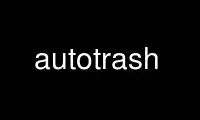
This is the command autotrash that can be run in the OnWorks free hosting provider using one of our multiple free online workstations such as Ubuntu Online, Fedora Online, Windows online emulator or MAC OS online emulator
PROGRAM:
NAME
autotrash — program to automatically purge old files from the FreeDesktop.org trash
SYNOPSIS
autotrash [-d purge_n_days_old]
autotrash [--delete number_of_megabytes_to_purge]
autotrash [--keep-free number_of_megabytes_to_free]
DESCRIPTION
autotrash is a program that looks in a FreeDesktop.org Trash folder for information on
it's contents and then purges a part of the trash depending on the options.
The most common option is -d, which will purge files that have been in the trash for more
then a given number of days.
The option --delete will remove at least the given number of megabytes from the trash,
removing the oldest trash first.
Using --keep-free will make sure at least the given number of megabytes of free space is
available, by automatically setting --delete to the right value. For example, to keep at
least a 1GB of free space, removing files from the trash if needed, use autotrash --keep-
free 1024 .
OPTIONS
This program follows the usual GNU command line syntax, with long options starting with
two dashes (`-').
-h --help Show a summary of options.
-d DAYS --days DAYS
Purge files older than DAYS number of days.
-T PATH --trash-path PATH
Use the given path as the location of the Trash directory, instead of the
default: ~/.local/share/Trash .
--max-free M
Only purge files if there is less than M megabytes of free space left at the
trash location. As an example, if you set this to 1024, then autotrash will only
start to work if there is less than 1GB of free space in the trash. Till that
time, autotrash will just exit normally without scanning the Trash directory. If
unsure, try running autotrash with --dry-run and --verbose to see the effect.
--delete M
Purge at least M megabytes, deleting oldest trash addition first. It uses trash
entries, NOT individual files. This means that if your oldest trashed item is a
1GB directory, and you request at least 10MB to be removed (M=10), autotrash
will remove 1GB. If unsure, try running autotrash with both --dry-run and --stat
to see the effect.
--min-free M --keep-free M
Make sure there is a minimum of M megabytes of free space. If there is less free
space, set --delete to the difference between M and the amount of free space. If
unsure, try running autotrash with --dry-run and --verbose to see the effect.
-D REGEX --delete-first REGEX
Purge any file which matches REGEX first, regardless of it's time-stamp. REGEX
must be a valid regular expression. If this option is used multiple times, the
files matching the first regular expression are deleted first, then the second
etc. Example, delete any *.avi files first, then by age: --delete-first
'.*\.avi'
-v --verbose
Output information on what is happening and why.
-q --quiet
Only output warnings.
--check Report .trashinfo files that point to a non-existing file. This will only happen
with a broken Trashcan. It is left up to the user to actually do something with
this information. These files will be removed as soon as the mentioned file
would be removed by autotrash.
--dry-run Only list what would be done, but actually do nothing.
--stat Show the number, and total size of files involved.
-V --version
Show the version of program.
EXAMPLES
Examples of program use.
autotrash -d 30
Purge any file that has been in the trash for more then 30 days.
autotrash --max-free 1024 -d 30
Only purge files from the trash if there is less than 1GB of space left on the
trash filesystem. If so, only trash files that are older than 30 days.
autotrash --min-free 2048
Purge files from trash, oldest first, till there is at least 2GB of space on the
trash filesystem. There is no restriction on how old trashed files are.
autotrash --min-free 2048 -D '.*\.bak' -D '.*\.avi'
Purge files from trash till there is at least 2GB of space on the trash
filesystem. If we need to remove files, make sure we remove *.bak files first,
then all *.avi files and after that the oldest to the newest. There is no
restriction on how old trashed files can get. Please note that '.*\.bak' and
'.*\.avi' are regular expressions and not glob patterns. Given that they are
regular expressions, using -D '.*\.(png|gif|jpg|jpeg)' will match images with
any of the given extensions.
autotrash --max-free 4000 --min-free 2048 -d 30
Start reading the trash if there is less than 4000MB of free space, then start
keeping an eye on. At that point, remove files older than 30 days and if there
is less than 2GB of free space after that remove even newer files.
@hourly /usr/bin/autotrash --max-free 4000 --min-free 2048 -d 30
Experienced users should consider adding autotrash as a crontab entry, using
crontab -e and adding the line above.
Use autotrash online using onworks.net services
